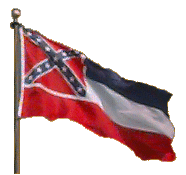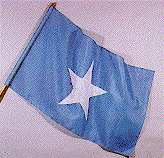
History of Mississippi Flags
The statements given here concerning the flags which have flown over Mississippi are taken from Four Centuries on the Pascagoula, Vol. 1, Copyright © 1953 by Cyril E. Cain.
 Spanish
Spanish
Flags of Spain, 1540-1630, 1780-1810. Hernando DeSoto carried the Royal Standard of Spain when he entered Mississippi near where Columbus now stands in the year 1540. This was the flag which Christopher Columbus had flown at his masthead when he discovered the New World, and it continued to be the flag of Spain for nearly two and a half centuries. This banner was quartered red and white; on the red a golden castle, the emblem of the province of Castile; on the white a lion, the emblem of the province of Leon. This flag was changed to the Bars of Aragon about 1787, and thus a second flag of Spain came over most of the State of Mississippi. This one had the central half yellow and the upper and lower parts red, with the coats of arms of Castile and Leon on the central part.
 British
British
Flags of Great Britain, 1630-1682, 1763-1783. In 1630 Charles I granted to some of his followers that part of America which extended "from Virginia to Florida and westward to the Great Ocean." According to the British this included all of what is now Mississippi. The British flag at this time had the red Cross of St. George and the white Cross of St. Andrew superimposed on the blue field of the old Scotch flag. The Cross of St. Patrick was not added till 1801.
 French
French
Flags of France, 1682-1763. LaSalle planted the white flag of the Bourbon kings of France at the mouth of the Mississippi River in 1682, and Iberville made the settlement at Ocean Springs under the same flag in 1699. Three golden fleurs-de-lis appeared on nearly all the Bourbon flags, though sometimes it was entirely white. The blue field of the French flag had officially disappeared by royal decree of Louis XIV in 1659.
 Lone Star
Lone Star
The "Bonnie Blue Flag," 1810 and 1861. The six coast counties came under the "Bonnie Blue Flag" in 1810 when Spanish West Florida revolted and set up the independent Republic of West Florida, which lasted officially for seventy-four days before it became a part of the United States. This flag had a blue field with a single white star in the center. A variation of this flag led the Texas Revolution in 1836 and appeared again in 1861 at the Secession Convention in Jackson. Thus it became the unofficial flag for the whole state for a few days until a flag was adopted on January 26, 1861. The flag inspired the song, "The Bonnie Blue Flag," which became the second best-loved song of the Confederacy after "Dixie."
 United States
United States
Flags of the United States, 1776-1861, 1865 to date. That part of Mississippi which was never in British West Florida came under the Grand Union flag of 1776 and under the Betsy Ross flag of 1777, but the other part of Mississippi, roughly the southern third, had as its first American flag the fifteen stars and stripes of 1795-1818. Then the plan to use thirteen stripes and as many stars as states in the union caused Mississippi to become the twentieth star in this constellation.
 Magnolia
Magnolia
Flag of the Republic of Mississippi, 1861. When Mississippi seceded from the United States on January 9, 1861, there was not yet any Confederate States of America, and thus another sovereign nation was born. After the unofficial waving of the Bonnie Blue flag for a few days, the convention adopted the Magnolia flag, which had a magnolia tree on a white field, and the canton corner had the Bonnie Blue reproduction. A reassembled convention in March made Mississippi a part of the Confederacy, and it thus came under the various flags of the Confederacy for the period of the War Between the States. The Magnolia flag continued as the state flag till 1894, when the legislature adopted the present red, white and blue flag with the Stars and Bars of the Confederacy in the canton corner.
 Confederate Battle Flag
Confederate Battle Flag
Flags of the Confederacy, 1861-1865. The Confederate States of America during the four years of its existence had three official flags, and one that never became official but was used more than all the others. During the first major battle of the war, Manassas, it became evident that the Confederate and Federal flags could not be distinguished each from the other. As a result of this confusion, three Confederate generals planned the Stars and Bars for battle use. They asked the Confederate Congress to adopt it in place of the official one, but this was never done. One change was made after two years, and another after two years more, but the best-known Confederate flag never became official. Its pattern was used for the canton corner of the last two.
 Mississippi
Mississippi
The Mississippi State Legislature adopted the present-day state flag in February 1894, replacing the Magnolia flag. This flag has a replica of the Confederate battle flag in the canton corner, although the language of the act creating the flag does not say so.
To summarize, seven sovereign nations have held dominion over the six counties of Mississippi which lie below the thirty-first parallel, and six nations over that area above this line.
Return to Mississippi Flag Proposal.
Last updated Thursday, January 22, 2015